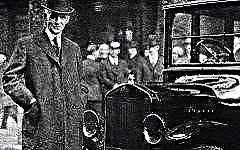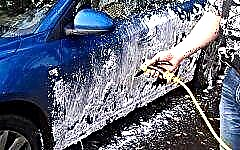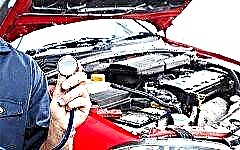

The content of the article:
- Coolant
- Checking the tightness
- Checking the radiator
- Important points of cooling system maintenance
- Prevention of malfunctions
The cooling system of a car engine must be given attention both in winter and in summer. Only full adherence to the maintenance rules can guarantee the correct functioning of the engine and help to avoid some problems.
The structure of the cooling system is quite complex. Failure of at least one unit may well lead to breakdown of the entire unit. It is very important to monitor the timely replacement of the coolant and the tightness of the system. This article will guide you through the first things to look out for when servicing your cooling system. Also, the issue of prevention of malfunctions will be touched upon here.
Coolant

Older drivers still remember the days when ordinary water was used to cool the engine. Now this practice is rather an exception to the rule. Nowadays, cooling water is used only in emergencies when antifreeze is not nearby.
The characteristics of antifreeze are very different from those of plain water and have a great advantage over them. So, any liquid intended for engine cooling has a higher boiling point and a lower one - freezing. In addition, antifreeze contains substances that have anti-corrosion properties and prevent the formation of limescale.
It is clear that it is much more expedient to use a special liquid in the cooling system than water, but the cooling system can be different. It is better to buy working fluids from reliable manufacturers, since the durability of their work directly depends on quality. And it can be different.
As a rule, low-quality liquids are cheap, so it's better not to pursue cheapness here. If we talk about Russian manufacturers of working fluids, then the preference is given to the company "Tosol-Sintez".
Another time-tested Russian company is Obninskorgsintez... From foreign manufacturers, one can mention Liqui Moly (Germany) and Motul (France).
Attention! Buying cheap coolants can corrode system parts. The aggressive acids contained in them may well make shells even in the cylinder head!
Checking the tightness

When buying antifreeze, you should look at the presence of fluorescent additives in it - with their help, leaks in the system are detected. This is very important, because no one doubts the need for its tightness.
Maintenance of the cooling system includes different stages, and one of them is precisely the tightness test. High-quality tightness not only ensures the safety of the working fluid, but in this case, boiling occurs only at 130 degrees. If the tightness is broken, then 108 degrees will be enough for boiling. Even the smallest crack in the system will help the liquid boil.
Therefore, it is very important to detect a crack in time in order to have time to eliminate the malfunction before it leads to serious consequences. It is for this purpose that special additives are used, which are included in the composition of modern coolants.
Such antifreeze will glow if ultraviolet light is directed at it. But not everyone has ultraviolet lamps, therefore, when operating a cooling system, certain rules must be observed:
- When the engine has cooled down, the "coolant" level should be between the MIN and MAX marks.
- A constant drop in the level of antifreeze indicates that it is leaking. This means that the tightness of the system is broken.
- The radiator should be inspected periodically. If any leaks are found, tighten the clamps and make sure that the cover is screwed on tightly.
Air locks can also contribute to the malfunction of the system - if air is present, it must be removed.
But first, about how to detect the presence of air - here are the steps you will have to do for this:
- Unscrew the expansion tank cap.
- The cabin heater must be turned on at full power and the engine must be run at idle for 3-4 minutes.
- The presence of air can be identified by bubbles that then appear in the expansion tank. If there are no bubbles, it means that there is no air either.
But if there is still air, then it must be expelled. To do this, the car should be parked so that it is slightly raised in front of it. Then the order of actions should be like this:
- Open the radiator and start the car.
- Let the engine run for 4-5 minutes with the heater on. Thus, the air will leave the system.
- After that, the motor is turned off and the radiator cap is closed.
Checking the radiator

Sometimes, when checking the radiator, you can find that it is warm only from the top, and its lower part is cold. This indicates clogging. The radiator could be clogged with rust or oil. Because of this, the motor may well overheat, so the clogged radiator must be cleaned.
Sometimes it becomes necessary to dismantle it. To do this, you first need to drain all the antifreeze, after removing the clamps from the hoses. After that, all hoses are removed, and the wires are disconnected. Sometimes the radiator is removed together with the casing. On some car models, the cover has to be detached.
It is important to check the condition of the brackets on the radiator. If they are damaged, then they are replaced. The radiator is installed in the reverse order.
Sometimes holes appear on the radiator pipes. They are removed by soldering. If it is not possible to solder the tube, it is muffled. In total, it is allowed to muffle up to three tubes. If there are more damaged tubes, then they are replaced. Sometimes, in this case, you have to change the entire radiator. Nowadays, many cars are equipped with radiators consisting of an aluminum core and a plastic barrel. It is useless to repair them - all that remains is to replace them. By the way, in no case should water be poured into such radiators, as this will certainly lead to corrosion of the pipes.
Important points of maintenance of the cooling system

There are some more points that you just need to pay attention to when servicing the engine cooling system. To prevent malfunctions, you need to systematically perform certain actions. But first, let's talk about the faults themselves, which can cause expensive repairs. Here is an almost complete list of them:
- the coolant overheats all the time;
- the liquid is supercooled all the time;
- the level of antifreeze is reduced (this factor indicates a violation of sealing);
- the pump for supplying liquid in operation is very noisy;
- electrolysis occurred in the antifreeze.
But what other reasons could be the constant overheating of the motor:
- the system could get clogged (in this case, clean becomes mandatory);
- the engine could overheat due to a jammed thermostat;
- the ignition timing was selected incorrectly;
- the fan drive has broken off (in this case, you cannot do without replacing it);
- the fan belt slips;
- the fan electromagnet is faulty;
- defective fan hydraulic coupling.
It is better to avoid overheating of the fluid, as this may well cause accelerated wear of the cylinders and pistons. Plain bearings and bushings also wear out very quickly in this case.
Prevention of malfunctions

And now it makes sense to talk about the prevention of malfunctions of the engine cooling system. Here are the steps to do this:
- Checking the density of antifreeze. For this, a special device is used - a hydrometer. If the density of the working fluid is too high, it makes sense to dilute it with distilled water. If the density is too low, a "coolant" is added to the system.
- Tensioning the drive. Incorrect fan belt tension is one of the main causes of engine overheating. This is especially true for fans with mechanical drives. If the belt is poorly tensioned, this will reduce the performance of the pump, which in turn will cause a decrease in the speed of rotation of the impeller.
- Cleansing the system from dirt. The radiator and motor must be clean. Dirt will greatly impede the cooling of the engine. The radiator can easily become clogged with debris - dust, dirt, leaves, etc. Debris can be easily removed by using a vacuum cleaner or a strong air jet. Dust and oil smudges from the engine must also be removed regularly.
- Diagnostics of the thermostat. The thermostat needs special attention - it should also be cleaned regularly. The correct operation of this device depends on the high-quality functioning of the engine and its heating temperature. Also, the thermostat is responsible for quickly warming up the motor after turning it on.
- Fan diagnostics. The fan also requires careful handling. On modern machines, manufacturers install fans with thermoelectric sensors built into the radiator. When the set temperature is reached, the sensors will close, which will help activate the fan and cool the system.
It may happen that the motor heats up quite strongly, but the fan continues to be inoperative. The temperature sensor is to blame for this. To check the performance of the sensor, it is necessary to close the contacts. If after that the fan starts to work, it means that the sensor is in a faulty state. If he "does not want" to work, the fan motor may be faulty. You can also check the electrical circuit.
The need for regular maintenance of an automobile engine cooling system is hardly worth proving. But knowing about this is not all, it is necessary to timely diagnose the state of this unit, which is of great importance for the high-quality operation of the engine.











